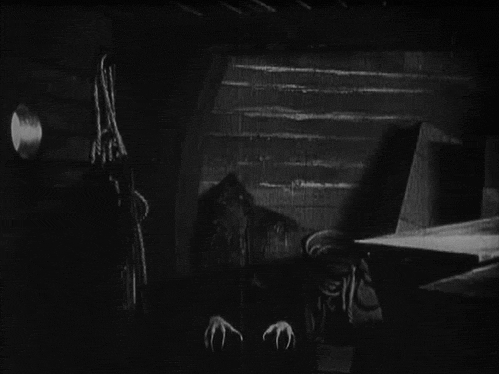We were asked in class whether or not copyright laws limit creativity. I have found an early example of an acclaimed creative work that would not have been possible if its creator didn’t blatantly ignore copyright laws.
The 1922 silent German horror film Nosferatu is probably best known to college-age folks for the cameo appearance in Spongebob Squarepants.
https://www.youtube.com/watch?v=yorZRDujbd0
Nosferatu is one of the very first horror movies ever made. It’s also a total rip-off of Dracula.
Director Albin Grau wanted to make a movie about a vampire. After doing some research, he decided to direct an adaptation of Bram Stoker’s novel Dracula. Bram Stoker was at this point deceased, and his copyrighted work belonged to his wife, Florence Stoker. All Grau had to do was get Florence Stoker to sell him the rights to make a Dracula movie. Unfortunely, Florence Stoker refused.

Grau was dismayed that he didn’t get permission to adapt Stoker’s copyrighted work, but he knew just what to do. He made the movie anyway.
Grau’s clever plan was to adapt the story of Dracula, but change the names of all the characters. For example, Count Dracula became Count Orlok. And instead of turning into a bat, Count Orlok would have powers more reminiscent of a rat. He wouldn’t be a vampire as much as a “nosferatu”… whatever that is.
Grau’s movie turned out to be a hit! It was a revolutionary movie that showed off state-of-the-art effects and told a great, if oddly familiar, story. All would be wonderful as long as Florence Stoker didn’t notice.

“I noticed.”
The court case that followed resulted in the judge ordering all copies of Nosferatu to be destroyed, but years later, a copy surfaced. Now Nosferatu can be seen by anyone and is studied by film enthusiasts and scholars decades later as one of the most influential creative works of cinema. Many horror movie clichés can actually be traced back to Nosferatu. And these clichés never would have been if it weren’t for Grau’s complete disregard for copyright rules.

Does this cliché vampire shot seem familiar? This is the original. Grau came up with this in his iconic copyright-infringing Nosferatu.
What goes around comes around, however, and now people can do anything with Nosferatu without Grau’s permission because the film is not copyrighted. Dracula is in the public domain (aka not copyrighted) in the United States because Stoker failed to follow proper copyright procedures, so that eliminates any copyright conflicts with Dracula, as well. You could upload it to YouTube and no one would complain.
In fact, it’s been done several times.
https://www.youtube.com/watch?v=F73hCPoEn44
You could even upload a dubstep remix of Nosferatu. Kind of pointless since it’s a silent film, but you could. People even remaster the film in different ways and sell their version of it, often claiming it to be most authentic with the clearest picture or most accurate color tinting or music that would have been used in theaters in the 1920s. People are making money off of Grau’s work just as Grau did with Stoker’s, but this time it’s legal.
We can see that copyright laws, to some extend, limit some creativity. While coming up with a totally original piece is a great show of creativity, it has been demonstrated that derivative works can be quite creative, too.
